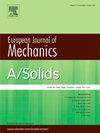A diffuse interface model for electro-chemo-mechanical systems
IF 4.2
2区 工程技术
Q1 MECHANICS
引用次数: 0
Abstract
Electro-chemo-mechanics plays a critical role in the performance and longevity of energy storage systems, such as lithium-ion batteries and hydrogen energy storage. These systems involve multi-material composites comprising both liquid and solid phases, with their behavior influenced by processes in the bulk phases and at their interfaces.
Traditional multi-phase theoretical and numerical models often adopt a discrete representation of material interfaces, introducing discontinuities in the problem’s fields. The numerical implementation is carried out using special interface elements, a methodology that requires conformal meshes and is not always supported by open-source computing platforms.
This paper introduces a novel modeling framework that employs a diffuse representation of material interfaces, inspired by the phase-field method. From a modeling perspective, this approach allows for the consistent coupling of bulk and interface electro-chemo-mechanical processes, adhering to thermodynamic principles. Numerically, the proposed model is particularly suited for simulating real material microstructures using regular meshes, facilitating advanced numerical implementations.
The methodology is detailed for a generic multi-material electro-chemo-mechanical system and applied specifically to Li-ion batteries. Numerical examples demonstrate the model’s effectiveness in simulating coupled interface processes without resorting to interface elements. This work provides a significant advancement in the simulation of electro-chemo-mechanical systems, offering a robust tool for studying the complex interplay of bulk and interface processes.
电化学机械系统的扩散界面模型
电化学力学对锂离子电池和氢能储存等储能系统的性能和寿命起着至关重要的作用。这些系统涉及由液相和固相组成的多材料复合材料,其行为受体相和界面过程的影响。传统的多相理论和数值模型通常采用离散的材料界面表示法,在问题场中引入不连续性。传统的多相理论和数值模型通常采用离散的材料界面表示法,在问题场中引入了不连续性。数值实现需要使用特殊的界面元素,这种方法需要保角网格,而且并不总能得到开源计算平台的支持。从建模的角度来看,这种方法可以在遵守热力学原理的前提下,将块体和界面的电化学机械过程一致地耦合起来。在数值上,所提出的模型特别适合于使用规则网格模拟真实材料微结构,从而促进先进的数值实施。该方法详细介绍了通用多材料电化学机械系统,并特别应用于锂离子电池。数值示例证明了该模型在模拟耦合界面过程时的有效性,而无需借助界面元素。这项工作在模拟电化学机械系统方面取得了重大进展,为研究块体和界面过程的复杂相互作用提供了强有力的工具。
本文章由计算机程序翻译,如有差异,请以英文原文为准。
求助全文
约1分钟内获得全文
求助全文
来源期刊
CiteScore
7.00
自引率
7.30%
发文量
275
审稿时长
48 days
期刊介绍:
The European Journal of Mechanics endash; A/Solids continues to publish articles in English in all areas of Solid Mechanics from the physical and mathematical basis to materials engineering, technological applications and methods of modern computational mechanics, both pure and applied research.

 求助内容:
求助内容: 应助结果提醒方式:
应助结果提醒方式:


